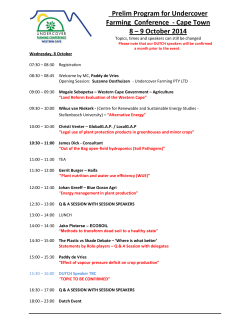
GUIDELINES FOR SESSION CHAIRS
XXXIII Scientific Instrument Symposium, Tartu, Estonia - GUIDELINES FOR SESSION CHAIRS Thank you for chairing a session at SIC 2014 You will find the abstracts and the biographical notes from the Book of Abstracts on our webpage. 1. Organization of Sessions – Meet your session speakers prior to the Session. – Typically, each session will be sequenced as follows: a) Brief introduction by the Chair; b) Oral presentations (20 min each); c) Discussion (please note that time available for discussion may vary from session to session); c) Final remarks by the Chair. – Chairs are free to manage discussion time: they can take one or two brief questions from the floor at the end of each talk, group papers for the purpose of discussion, etc. However, it is important that the session does not extend beyond its allocated time slot. 2. Role and Responsibilities of Chairs – Make contact with the audience to get everyone's attention and to introduce the topic(s) that will be addressed in the session. – Introduce and thank speakers for their contribution. When introducing the speaker, it is customary to mention the title of the presentation and add a few words about the speaker. If the presentation has been co-authored, it is advisable to mention the names of the co-authors as well. In general, keep the introduction concise and accurate. – Ensure good timekeeping so that there are no delays or over-runs. Presentations must start and finish on time. Never rely on the speaker to have eye contact with you on a regular basis to determine how much speaking time is left, so you may have to speak up and remind the speaker that he or she is running out of time. – It is good practice to sum up the session after the last presentation – for example a few sentences summarising content, a final acknowledgement to all the speakers and a few remarks to trigger the discussion. – A major element of the chair’s role is to make the session lively and as participative as possible and to help focus the discussion. To achieve these goals: a) ask people making comments and questions from the audience to introduce themselves and limit themselves to short comments or questions, avoid long speeches; b) manage the general discussion, by, if necessary, adding your personal comments and/or questions, and by highlighting issues not fully clarified; – If there are no questions from the audience, it is good to ask one or two questions yourself. If there are just a few questions, do not artificially extend the session; go on to the next speaker or wind up the session. – If there are too many questions, you may step in and remind the audience that the discussion may continue after the session.
© Copyright 2025





















